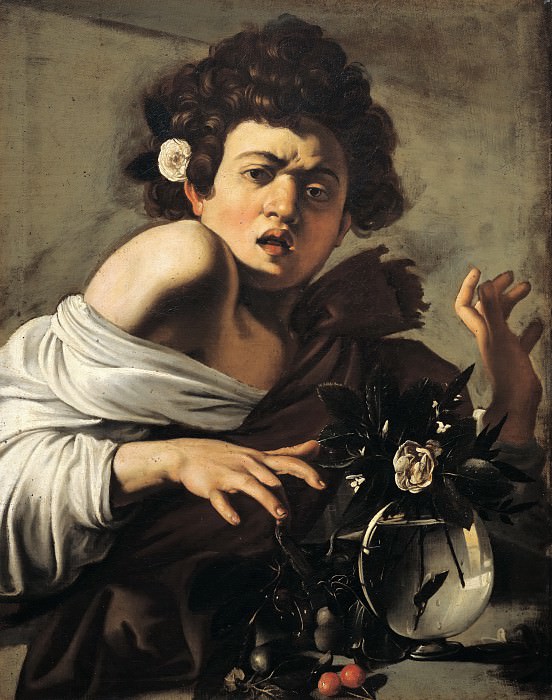Boy Bitten by a Lizard Michelangelo Merisi da Caravaggio (1571-1610)
Michelangelo Merisi da Caravaggio – Boy Bitten by a Lizard
Edit attribution
Download full size: 3000×3811 px (3,1 Mb)
Painter: Michelangelo Merisi da Caravaggio
We see a boy being bitten in the finger by a lizard. He jumps up in sudden pain. The reptile was hiding in the fruit. The artist places a lovely still life between us and the teenager. Our attention is drawn to the vase in which stands a delicate branch of jasmine. Next to the vase we can see red and green cherries. In the vessel, the outline of which curves, the room is intricately reflected. Before us is the most impressive genre still life.
Description of Michelangelo Merisi da Caravaggio’s The Boy Bitten by the Lizard
We see a boy being bitten in the finger by a lizard. He jumps up in sudden pain. The reptile was hiding in the fruit. The artist places a lovely still life between us and the teenager.
Our attention is drawn to the vase in which stands a delicate branch of jasmine. Next to the vase we can see red and green cherries. In the vessel, the outline of which curves, the room is intricately reflected.
Before us is the most impressive genre still life. The artist was able to truly realistically portray the boy’s instantaneous reaction to the bite. It is quite likely that this is an allegory. Caravaggio depicts the pain of the soul caused by his unrequited love.
The artist uses all kinds of techniques. The light is contrasting. One shoulder, as if illuminated by the bright light of the spotlight, while the other is hidden.
We can feel the maximum naturalism of the scene that the artist depicts. The viewer can sense the pain in the creased face of the hero of his canvas. The well-groomed skin contrasts sharply with the dirt under his fingernails, which is typical of street boys.
Caravaggio enjoys his own skill. He conveys all the details with ease: the reflection of the door in the vase. But this halted moment can be interpreted in different ways. Some scholars believe that this painting represents the pain that a strong feeling can cause. Others believe it to be an unusual metaphor for the rapid passage of youth. It is likely that the painter wanted to portray the suffering of a love that remained unrequited.
Considering that Caravaggio depicts a boy with a rose behind his ear, it is likely that this interpretation is correct. As you know, this flower symbolized Venus. The cherry, on the other hand, was a symbol of reward for all virtues. It is possible to interpret this work in different ways.
Кому понравилось
Пожалуйста, подождите
На эту операцию может потребоваться несколько секунд.
Информация появится в новом окне,
если открытие новых окон не запрещено в настройках вашего браузера.
You need to login
Для работы с коллекциями – пожалуйста, войдите в аккаунт (open in new window).




















COMMENTS: 1 Ответы
Он был лучше Леонардо в соответствии всех пропорций тела – да и души – все было откровенно и без лукавинки... увдим не мы, но время...! Не все ЭКСПОНАТЫ прекрасного художника до сих пор выставлены, все равно, через 50 лет их, мэтров, сравняют!!! Неизвестно, кто победит???..
You cannot comment Why?
The subtexts of this painting are multifaceted and open to interpretation. The immediate event -- a boy being bitten by a lizard -- can be seen as a symbol of unexpected pain and the vulnerability of youth. The contrast between the delicate rose in his hair and the sharp pain he experiences suggests a fleeting beauty disrupted by harsh reality. The presence of the fruit, particularly the cherries, can allude to innocence and ripeness, perhaps foreshadowing a loss of that innocence through painful experience. The water in the glass bowl, reflecting light and distortion, might symbolize the fleeting nature of perception or the way lifes events can warp ones view. Some art historians interpret the painting as an allegory for love (represented by Venus) and the pain it can inflict, with the lizard symbolizing desire or a sudden, shocking encounter that leads to distress. The stark realism and emotional intensity of the boys reaction are hallmarks of Caravaggios style, often exploring the darker, more visceral aspects of human experience.